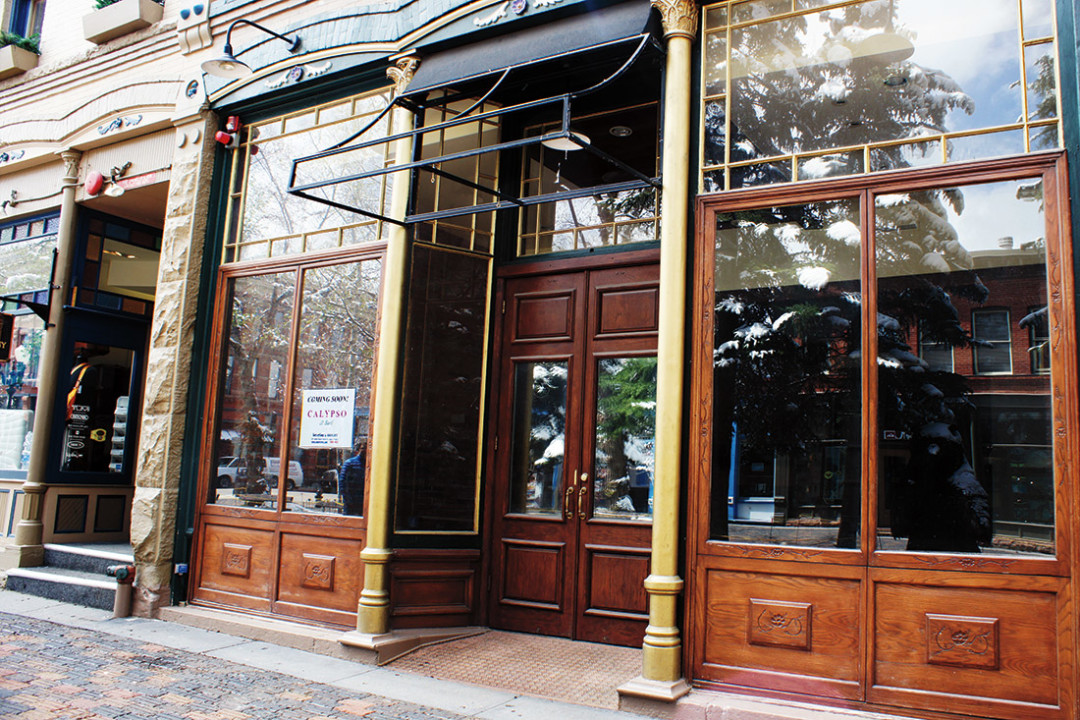Core Values

Image: Nancy M. Mayer
Walking down the Hyman Pedestrian Mall in mid-May, I did a double take upon seeing a sign in a vacant storefront’s window: Coming Soon! Calypso St. Barth. That a retailer named for another swank resort town was coming to Aspen did not surprise me. That Calypso St. Barth would occupy this particular spot on the Hyman Mall most certainly did, as the space had been vacant for what felt like forever. (The period of time was actually about seven years, according to Karen Setterfield, the commercial real estate broker who negotiated its lease.)
Many Aspen locals viewed the Hyman space’s ongoing vacancy as the epitome of an unfortunate new reality defining Aspen’s retail climate. In the relentless high-ending of stores in the downtown core—driven by ever-skyrocketing rents, the conventional wisdom goes—lease terms had at last arrived at a price-per-square-foot line in the sand, with the landlord seemingly unwilling to budge. Hazarding guesses about who would eventually step up and pay the asking price became local sport: Dolce & Gabbana? Cartier? Michael Kors?
The truth behind the vacancy on Hyman, Setterfield says, wasn’t so dramatic: the man who owned the building—he bought it in 2005 and lost it in foreclosure last year—was inexplicably passive about renting the space. Setterfield says she received a call inquiring about it “almost every day.” This was a case not of a hard-line landlord, but of an oddly indifferent one.
Still, the curious case on Hyman shines a light on two competing narratives about Aspen’s downtown core. On one side you have concerns about the retail mix becoming inaccessible to many working-class locals. That means a less diverse mix of people shopping in the core, which saps vibrancy. Even worse, some say, is the prospect that Aspen is finally turning into the stereotyped version of itself. Whereas town once dispelled its glitz-and-glam reputation as much as it confirmed it, the current retail mix, which represents the first formal impression of town for many visitors, now fits the clichéd narrative of so many lazily written travel stories: A luxury hideaway for the rich and famous, Aspen sits nestled in the Rocky Mountains…
Moreover, when retail turnover occurs, the swaps almost always shift the balance toward the higher end, particularly if a building is being demolished and rebuilt. After the ramshackle structure that housed Bad Billy’s was torn down in 2011, that grungy locals bar was replaced by luxury Italian clothier Brunello Cucinelli in a new building the following year. The same thing happened when the Gap building at the corner of Galena and Mill Streets was reduced to rubble: the inexpensive chain was exchanged for Theory, a clothing store with prices three or four times higher.
The flip side of the argument is that—who are we kidding here?—Aspen itself is and has long been a luxury brand. In many ways, the only surprising aspect of Aspen’s retail makeup is that luxury retailers haven’t come to dominate it sooner. For those who haven’t been paying attention, the world is in the midst of a wealth boom, and many newly minted billionaires have Aspen on their radars. (Or at least the guys flying their private jets do.) They’re spending time and money in Aspen, so it’s only natural that stores catering to their tastes would appear.
But the us-versus-them framing of the debate may not work. For starters, as Setterfield points out, while the arrival of international brands such as Helmut Lang and Calypso St. Barth tends to incite the most chatter, largely because they grab the most prominent retail locations in town, she can rattle off three locally owned businesses that open or relocate somewhere in town for every one big-name brand that does. Many of those locally owned stores may be selling high-end goods, but they’re also more likely to have locals-friendly offerings, too, as well as deeply discounted sales at least a couple of times a year. And since the stores’ owners are almost always another local’s neighbor or friend, it’s tough to root against them.
Even the concern that a luxury retail mix appeals only to a certain type of tourist is likely an oversimplified assumption. A few years ago, the Aspen Chamber Resort Association hired Art Webb and his BCF brand consultancy to research how the Aspen brand was defined both locally and out of town. Webb discovered the predictable: people from outside of Aspen perceive it as expensive, exclusive, and difficult to reach. But Webb says he also learned that “there are a lot of middle-income folks who stumble into Aspen. They won’t spend a dime in the luxury retail stores, but it may be less of a turnoff than one might assume. Retail in Aspen is almost an attraction like a theme park would be. Visitors wander through wide-eyed and amazed.”
Plenty of cool places have luxury shopping as part of their experiences: Paris, Chicago, New York. No one accuses those towns of selling their souls. But they’re also vastly bigger. A whole luxury district can exist in New York or L.A. without drowning out other sensibilities.
So is the local angst misguided? Perhaps. Or more likely just naïve. But for the many longtime Aspenites whose memories include wandering down Galena Street and the pedestrian malls with $50 in their pockets and having a slew of options of where to spend them, there’s a sense of storefront after storefront falling away.
Is it possible for the locals who carry that nostalgia to adopt the mind-set of the wide-eyed tourist, marveling at the fineries on display with the current retail mix as they might ogle the exotic animals on a trip to the zoo? Possible or not, it would seem wise to start trying.













































